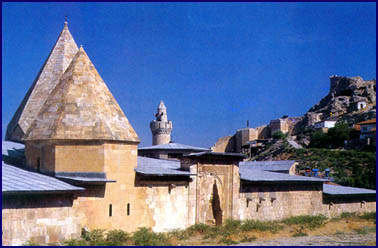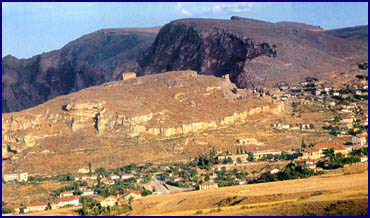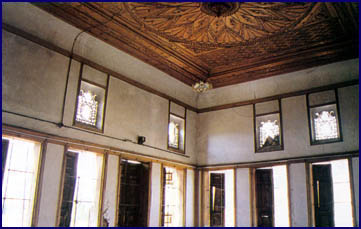|
|
|
 One of the earliest Turkish principalities in Anatolia, the
Mengücek rulers bore the titles of şah and melik (shah and king
respectively). In the 12th and 13th centuries they constructed magnificent buildings in
their capital city of Divriği in the Turkish province of Sivas. Divriği consists of
houses with gardens and orchards spread out over a wide area. Prof. Dr. Metin Sözen,
president of the Çekül Foundation, Prof. Dr. Cengiz Eruzun of Mimar Sinan University and
I arrived in Divriği one sunny day in May. The city lies in a mountainous region of
eastern Turkey, at the foot of the towering snowcapped heights of Yama Dağ, its peak
hidden in mist, and faces a sloping plain to the south. The Yılanlıdağ range to the
north and Akdağ to the west are spectacular with their deep canyons. Between is the
Anatolian plateau at its most splendid, with hills of purple, red, blue, grey and brown
lying like sculpted dinosaurs. One of the earliest Turkish principalities in Anatolia, the
Mengücek rulers bore the titles of şah and melik (shah and king
respectively). In the 12th and 13th centuries they constructed magnificent buildings in
their capital city of Divriği in the Turkish province of Sivas. Divriği consists of
houses with gardens and orchards spread out over a wide area. Prof. Dr. Metin Sözen,
president of the Çekül Foundation, Prof. Dr. Cengiz Eruzun of Mimar Sinan University and
I arrived in Divriği one sunny day in May. The city lies in a mountainous region of
eastern Turkey, at the foot of the towering snowcapped heights of Yama Dağ, its peak
hidden in mist, and faces a sloping plain to the south. The Yılanlıdağ range to the
north and Akdağ to the west are spectacular with their deep canyons. Between is the
Anatolian plateau at its most splendid, with hills of purple, red, blue, grey and brown
lying like sculpted dinosaurs.  Ancient cultures built either forts or
tombs on each one. On this plateau lying between the Lik and Çaltı rivers and surrounded
by canyons and precipices is a town out of the past, keeping history and past culture
alive. Of all the architectural monuments built in Anatolia over the millenia, perhaps
none can compare as a work of art to Ahmed Şah Ulu Mosque with its remarkable decoration. Ancient cultures built either forts or
tombs on each one. On this plateau lying between the Lik and Çaltı rivers and surrounded
by canyons and precipices is a town out of the past, keeping history and past culture
alive. Of all the architectural monuments built in Anatolia over the millenia, perhaps
none can compare as a work of art to Ahmed Şah Ulu Mosque with its remarkable decoration.
But it was not just the mosque and the adjoining Melike Turan Melek Darüşşifa or hospital which attracted us to Divriği. Here there is the only surviving Turkish castle monument, Arslanburç; one of the earliest Friday mosques built in Anatolia, Süleyman Şah or Kale Mosque; Mengücek and Memluk kümbets (mausoleums); hamams (baths); castle; bedesten (commercial building where merchants stored and traded their goods); medrese (college); ruined churches; fountains; bridges, and above all the old houses of Divriği which have many of the features of mediaeval Seljuk domestic architecture. The latter were the main purpose of our visit. First we went to the municipality and drank coffee with the mayor, and then went to the two hundred year old Budaklıoğulları House, where a magnificent dinner of local cuisine was served in the garden. Those of our party who had never entered a Divriği house before were astonished by the spacious interior, decoration and plan of the house, which was large despite the fact that the selamlık (quarters for receiving male guests) had been demolished at some point, leaving the harem, the main private part of the house, and the mabeyn section which linked them. But there were still many old houses to visit in the two days, and even two weeks would not have surficed to visit them all.
In the evening the guests were entertained by the Div-Han General Directorate and listened to a talk about Evliya Çelebis account of Divriği in the 17th century. The following day we met at the Taşbaşı Meadow and divided into groups according to our particular interests. On that sunny May day Divriği was full of people hurrying to fit in as much as possible. Cameras clicked incessantly everywhere; in the castle, the old town centre, the mansions of Âyan Ağa and Abdullah Paşa, the Seljuk mausoleums, mos-ques, and the old houses with earth or tiled roofs. The houses of adobe, wood and stone, with their pavilions, reception rooms, banqueting rooms, upper windows, lovely ceilings, fireplace hoods, intricately worked doors, carved eaves, and decorative keyholes were recorded in thousands of photographs. In the afternoon we attended a ceremony and discussions celebrating the 18th Historic Turkish Houses Week, and in the evening ate traditional Divriği pilaf at the openair celebrations organised by the municipality on Taşbaşı Meadow. The lecture that last evening was on the history and future of Divriğis iron mines. When we departed the following morning everyone agreed that Divriği was a unique and undiscovered treasurehouse of Anatolia. |
Source: Skylife By Necdet SAKAOĞLU |


 Our large group of academics, architects, art historians and experts then
met at Ulu Mosque, which has been declared part of the World Heritage by UNESCO. We
proceeded to examine every part of this wonderful building, with its portals, niche,
pulpit, columns, royal gallery, cells, in-scriptions, and decorations symbolising the
delights of paradise promised in the Koran. We next went to the house of Topçuoğlu Osman
Ağa, from which there was a superb view over the town in the late afternoon sun. But it
was not the view but the main room of this house which preoccupied us most. This huge
room, which remains exactly as it was a hundred and fifty years ago, has a ceiling with a
spiralling design, pillars, beams, railing and windows all beautifully carved and
decorated. Around the walls are divans which easily ac-commodated all of us.
Our large group of academics, architects, art historians and experts then
met at Ulu Mosque, which has been declared part of the World Heritage by UNESCO. We
proceeded to examine every part of this wonderful building, with its portals, niche,
pulpit, columns, royal gallery, cells, in-scriptions, and decorations symbolising the
delights of paradise promised in the Koran. We next went to the house of Topçuoğlu Osman
Ağa, from which there was a superb view over the town in the late afternoon sun. But it
was not the view but the main room of this house which preoccupied us most. This huge
room, which remains exactly as it was a hundred and fifty years ago, has a ceiling with a
spiralling design, pillars, beams, railing and windows all beautifully carved and
decorated. Around the walls are divans which easily ac-commodated all of us.